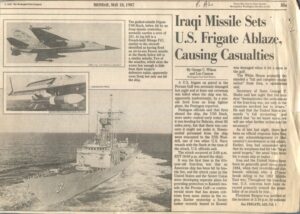Embedded below is the typescript of the remote viewing session done by me, then-Captain Paul H. Smith USA against a target event that didn’t occur until 50 hours into the future. The tasking, as formulated by the monitor, Ed Dames was approximately: “Describe the most important event for us to know about in the next few days.” This constituted what we referred to in the Star Gate remote viewing unit at Ft. George G. Meade as an “open tasking”—a sort of psychic “fishing expedition,” just to see what might turn up.
Using the coordinate remote viewing methodology I had learned from Ingo Swann and Dr. Harold E. Puthoff, I started the session at Dames’ direction at 10:23 in the morning on 15 May 1987. The session ended at 11:36 AM EDT, for a total of one hour and thirteen minutes. About the time I felt I had got all that I was going to, Dames, who had his own preconceptions about what the tasking would produce, ended the session. He opined that I was “off” (that is, that I had not tuned into the remote viewing signal and thus had produced no useful information). He instructed me to go ahead and file my session in my safe drawer. At the end of the day, we all departed the office and went home for the weekend.

On Monday morning, as I was getting my kids ready for school, our operations and training officer, Capt. Fred “Skip” Atwater phoned to ask where my Friday session was. “It’s in my safe drawer. Why do you ask? I was off on the session.” Skip’s response was: “I guess you haven’t seen this morning’s paper!” I retrieved my copy of the Washington Post and looked at the front page, which you can see displayed to the right. It read “Iraqi Missile Sets US Frigate Ablaze, Causing Casualties.”
The news story substantially confirmed the information I had perceived and reported in my remote viewing session from two days before. That Monday morning my commander requested I prepare a complete, accurate typescript of the session (since my handwriting often becomes hard to read when I am deeply engrossed in a session), so that it could be transmitted up the chain of command at the Defense Intelligence Agency. I included a summary of my findings. Unfortunately I have not found a copy of the summary. But the session speaks for itself. You can judge from the transcript below how accurate the session in comparison to an account and analysis of the attack linked here.
Stark_Session_typescript_01